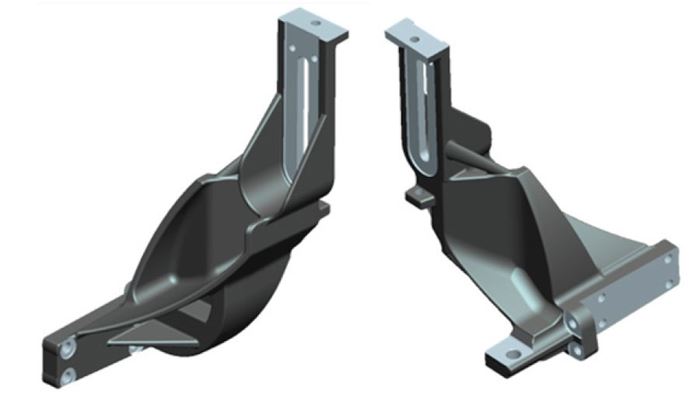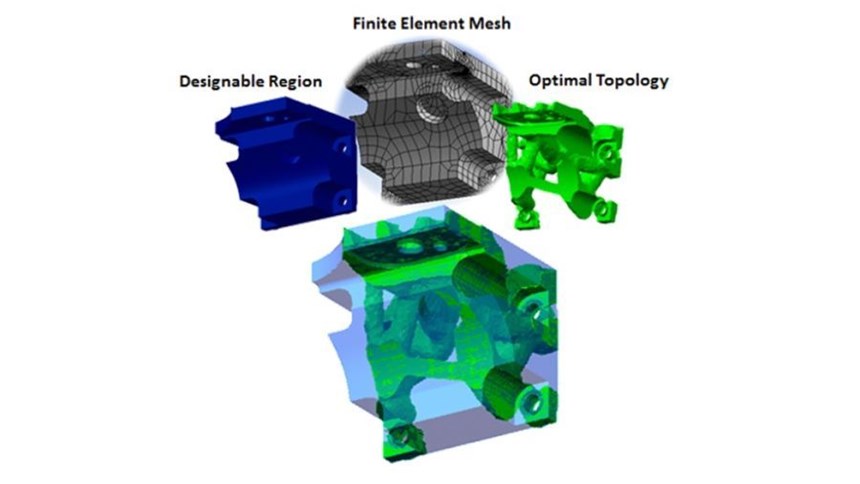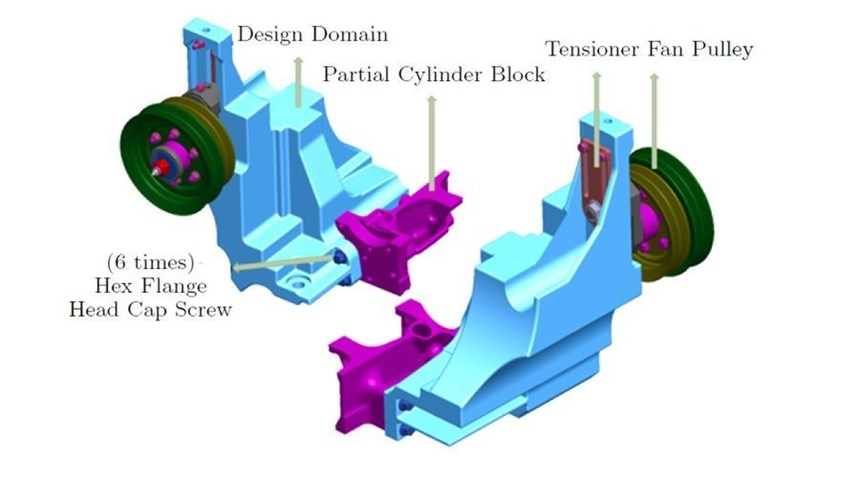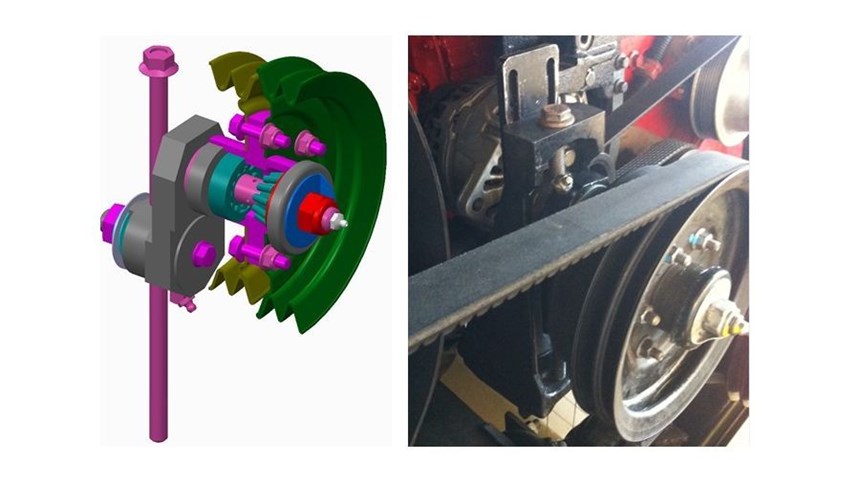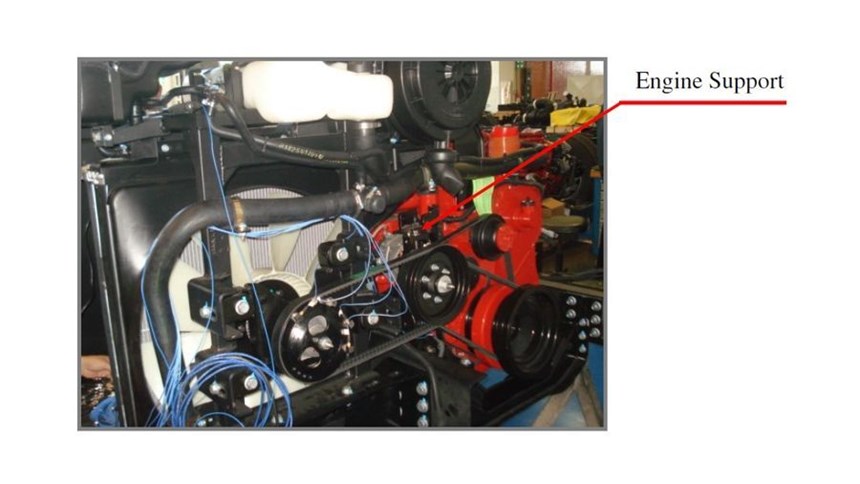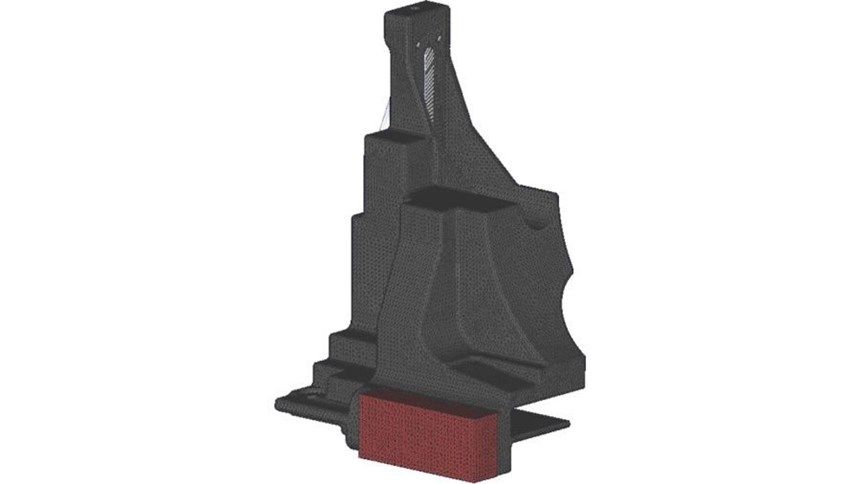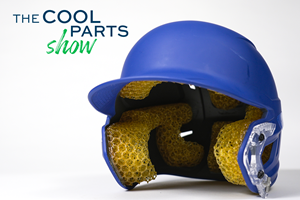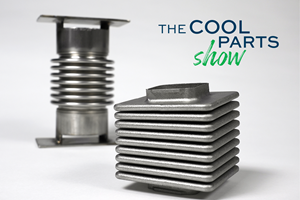Design for AM: Diesel Engine Support Optimized for Savings and Performance
A diesel engine support, connecting the powertrain and the vehicle chassis, is optimized for weight savings, performance and manufacturing cost reduction as a result of redesigning the part for AM.
Engineers from Cummins Brazil, the Polytechnic School of the University of São Paulo, Brazil, and the University of Ontario Institute of Technology in Oshawa, Canada, recently exploited additive manufacturing’s design freedom to improve the structural capability of a diesel engine support that also provides an anchor point for the fan-driving pulley. In this proof of concept involving a new design tailored to these multiple, specific functions of the part, the results the team won were weight minimization, performance improvement and a reduction of manufacturing costs.
The team presented its work in a technical paper, “Topologically Optimized Diesel Engine Support Manufactured with Additive Manufacturing” (see the end of this article for more information). Presented here is a summary of the project and what it shows in terms of the practice and possibilities of redesigning an engineered part for AM.
AM and Topology Optimization
Almost any shape can be manufactured with AM. The design process for a part to be made through AM can focus on not only combining functions within the component, but also optimizing the weight-to-performance ratio. AM is the manufacturing process perhaps easiest to pair with topology optimization, which aims to selectively place material in locations required by the part’s function. Topology optimization tends to increase the geometric complexity of the component, which is problematic in conventional manufacturing, where increased complexity leads to higher costs. But in AM, where complexity is of little concern, the optimization can be used to reduce material and weight, reducing costs.
Yet not all components of a mechanical system are equally suited for additive manufacturing. A design analysis is necessary to identify those components where AM can provide the biggest benefit.
Success Requirements for AM-Specific Design
To be successful, the design or redesign of a component for AM needs to bring technological and economic benefits by (A) lowering manufacturing costs—perhaps by simplifying the assembly or limiting the investment in expensive, part-specific tools—or (B) adding benefits during product operation by lowering operating costs, raising performance or delivering unique capability.
Demand for low-cost, reliable, durable, lightweight components in the automotive industry is pushing engineers and researchers toward reevaluating component designs in search of these benefits. A diesel engine support, conventionally machined out of a metal block, is an excellent candidate for redesign with these benefits in mind.
Design Analysis and Choice of AM Technology
The choice of AM technology must be determined early on in the redesign of a part, as it will determine the right set of design rules.
“Additive manufacturing” is actually an umbrella term encompassing a suite of technologies where the common denominator is the ability to produce a part by successive and selective accumulation of material. Each technology has specific advantages that can be drawn upon in different ways to achieve efficient manufacturing of challenging components.
Among metal additive manufacturing processes, selective laser melting (SLM) belongs to the powder bed fusion category. Also known as direct metal laser melting, the technique is named after its fundamental mechanism. The process relies on scanning a fine laser beam across successive layers of a powder bed to selectively melt intricate tracks. The final components arise from solidification of the melted powder. The ability to produce high-resolution features is one of the reasons why SLM is a process often selected to produce complex components with fine features. It was chosen to manufacture the new diesel engine support.
Compared to conventional subtractive or formative methods, the advantages of SLM are reflected in four key aspects. They are:
- Shape complexity. It is possible to manufacture virtually any shape with the SLM build. Fabricating small lot sizes is economically viable, and customized and optimized geometries are possible.
- High resolution. The material is processed with a fine laser beam, point-by-point and one layer at a time.
- Hierarchical complexity. On machines with sufficient resolution, the fabrication of fine features means that complex hierarchical multi-scale structures can be designed and fabricated in one step with feature sizes spanning the macro- and meso-scale (0.1 to 10 mm).
- Functional complexity. Geometrical flexibility makes it possible to integrate multiple functions into a single component that would otherwise be made out of multiple parts.
Diesel Engine Support and Its Environment
In an internal combustion engine, the engine support is a component responsible for holding the powertrain system, including not just the engine but also the transmission and accessories, while linking the power train to the vehicle chassis.
A related system, the cooling drive system, includes three pulleys: the driver pulley attached to the crank shaft nose, the intermediate pulley applying tension to the system’s belt and the slave pulley driving the fan. The diesel engine support also anchors this intermediate pulley.
The part was topologically optimized around these two separate functions of the component, both connecting the powertrain and chassis, and supporting the tensioner pulley.
Combining Design for SLM and Topology Optimization
Despite there having been successful cases of redesign for SLM, formal dedicated rules for how to do this are still under development. Most such rules are developed in-house by users and guarded as a significant commercial advantage. Also critical is an AM design workflow that promotes efficient redesign and coordinates topology optimization with design for manufacturing. That workflow must include and consider the following:
- The capture of the component’s requirements
- An understanding and consideration of SLM benefits and constraints
- Anticipation of postprocessing techniques during the design stage
- Allowance for fabrication time and costs
Capturing Component Requirements
The demands on the engine supports mostly relate to load bearing. In order to properly determine the loads involved in the optimization problem, a prototype of the entire vehicle was tested in a special track. Accelerations experienced by the system were monitored using accelerometers distributed throughout the powertrain system.
Relevant load values were obtained in other ways as well. The magnitude and direction of hub loads related to the cooling system were obtained numerically using commercial software that takes into account belt material, curves of power consumption versus engine speed, and vehicle duty cycle, among other factors. The clamp load was measured using an ultrasonic device.
The data were fed into a finite element model of the cylinder block, bolts and tensioner pulley to begin the iterative computational process of mathematical optimization of the form.
Realizing Optimization through Design Freedom
In the course of this kind of analysis, it is important to recognize the extent to which additive manufacturing relaxes constraints in the design domain. The relaxation can allow designers to adopt a topology optimization technique directly focused on functionality. Given the applied loads, boundary conditions and designable volume, the solver can find the most structurally efficient amount and distribution of material.
Yet designers often over-constrain the topology optimization problem in seeking to ensure that the solution is manufacturable. This practice is prone to cause waste, and can fail to take full advantage of the design freedom of AM. For the sake of competitiveness, and for the sake of realizing AM’s potential, it is crucial for designers using AM to be aware of the full capabilities of their AM process and update their design constraints accordingly.
Source: This article is based on the paper, “Topologically Optimized Diesel Engine Support Manufactured with Additive Manufacturing,” by Tadeus R. Marchesi of Cummins Brazil; Ricardo D. Lahuerta, Emlio C. N. Silva, Marcos S. G. Tsuzuki and Thiago C. Martins of the Polytechnic School of the University of São Paulo; and Ahmad Barari and Ian Wood of the University of Ontario Institute of Technology. Find the paper at gbm.media/engnsuppt.
About the author: Stéphanie Giet is a specialist in laser-based additive manufacturing. Her experience spans the AM process chain from design for AM and process development to production readiness. Based in the U.K., she currently works for a manufacturer of laser-based powder-bed fusion technologies. She blogs at insidemetaladditivemanufacturing.com.
Related Content
Implicit Modeling for Additive Manufacturing
Some software tools now use this modeling strategy as opposed to explicit methods of representing geometry. Here’s how it works, and why it matters for additive manufacturing.
Read More3D Printed Lattices Replace Foam for Customized Helmet Padding: The Cool Parts Show #62
“Digital materials” resulting from engineered flexible polymer structures made through additive manufacturing are tunable to the application and can be tailored to the head of the wearer.
Read MorePreassembled Turbojet Engine, 3D Printed in One Build: The Cool Parts Show #75
Turbojet engines typically consist of hundreds or thousands of parts, but this engine — 2023 winner of The Cool Parts Showcase for Best Proof of Concept — was 3D printed as just two pieces, with the monolithic rotor embedded inside the stationary engine shell.
Read MoreFlexible Bellows Made Through Metal 3D Printing: The Cool Parts Show #64
Can laser powder bed fusion create metal parts with controlled flexibility? We explore an example in this episode of The Cool Parts Show.
Read MoreRead Next
Profilometry-Based Indentation Plastometry (PIP) as an Alternative to Standard Tensile Testing
UK-based Plastometrex offers a benchtop testing device utilizing PIP to quickly and easily analyze the yield strength, tensile strength and uniform elongation of samples and even printed parts. The solution is particularly useful for additive manufacturing.
Read More3D Printed Polymer EOAT Increases Safety of Cobots
Contract manufacturer Anubis 3D applies polymer 3D printing processes to manufacture cobot tooling that is lightweight, smooth and safer for human interaction.
Read MoreAlquist 3D Looks Toward a Carbon-Sequestering Future with 3D Printed Infrastructure
The Colorado startup aims to reduce the carbon footprint of new buildings, homes and city infrastructure with robotic 3D printing and a specialized geopolymer material.
Read More
